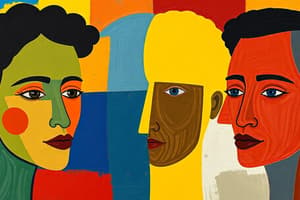Podcast
Questions and Answers
What measure assesses implicit bias in relation to prejudice?
What measure assesses implicit bias in relation to prejudice?
- Association Task Measure (correct)
- Skin conductance measures
- Self-report questionnaires measure
- Donations to charity measure
Which component of prejudice involves generalizations about a group?
Which component of prejudice involves generalizations about a group?
- Behavior
- Emotional Response
- Affective Bias
- Cognitive (correct)
Which factor is NOT typically involved in the development of prejudices?
Which factor is NOT typically involved in the development of prejudices?
- Physical appearance (correct)
- Direct experience
- Social Learning
- Operant conditioning
What type of social categorization is problematic for prejudice?
What type of social categorization is problematic for prejudice?
What is the emotional reaction component of prejudice called?
What is the emotional reaction component of prejudice called?
What is a common example of discrimination in the context of prejudice?
What is a common example of discrimination in the context of prejudice?
How does Social Identity Theory relate to prejudice?
How does Social Identity Theory relate to prejudice?
Which common type of prejudice specifically targets gender?
Which common type of prejudice specifically targets gender?
What effect describes the tendency to perceive individuals in an outgroup as more similar than they actually are?
What effect describes the tendency to perceive individuals in an outgroup as more similar than they actually are?
What occurs when judgments about an entire group are influenced by the behavior of a single group member?
What occurs when judgments about an entire group are influenced by the behavior of a single group member?
Which research showed that outgroup members' behavior influences expectations about the entire outgroup?
Which research showed that outgroup members' behavior influences expectations about the entire outgroup?
What model suggests that inducing a superordinate identity can reduce prejudice among different groups?
What model suggests that inducing a superordinate identity can reduce prejudice among different groups?
What is the main limitation of the Common Ingroup Identity Model?
What is the main limitation of the Common Ingroup Identity Model?
Which model allows both subgroup identity and shared group identity to coexist?
Which model allows both subgroup identity and shared group identity to coexist?
What behavioral intention may arise from negative portrayals of outgroup members, such as obese people?
What behavioral intention may arise from negative portrayals of outgroup members, such as obese people?
How can ingroup bias be reduced according to the categorization approach in the Common Ingroup Identity Model?
How can ingroup bias be reduced according to the categorization approach in the Common Ingroup Identity Model?
What effect does the Minimal Groups Paradigm suggest occurs with minimal conditions?
What effect does the Minimal Groups Paradigm suggest occurs with minimal conditions?
What was the primary finding from Tajfel et al.'s (1971) experiments on minimal groups?
What was the primary finding from Tajfel et al.'s (1971) experiments on minimal groups?
According to Navarrete et al. (2012), how do people learn to fear their outgroup compared to their ingroup?
According to Navarrete et al. (2012), how do people learn to fear their outgroup compared to their ingroup?
What role does cognitive dissonance play in prejudiced behavior according to Berscheid et al. (1968)?
What role does cognitive dissonance play in prejudiced behavior according to Berscheid et al. (1968)?
What is a key reason for hostility within ingroups as indicated in Navarrete et al.'s study?
What is a key reason for hostility within ingroups as indicated in Navarrete et al.'s study?
How does the Minimal Group Paradigm affect self-esteem according to the findings?
How does the Minimal Group Paradigm affect self-esteem according to the findings?
What can happen when individuals justify their prejudiced behavior?
What can happen when individuals justify their prejudiced behavior?
What was the primary method used in Navarrete et al.'s study to create ingroups?
What was the primary method used in Navarrete et al.'s study to create ingroups?
What is a key element necessary for the well-being of both urban residents and rural-to-urban migrants in China?
What is a key element necessary for the well-being of both urban residents and rural-to-urban migrants in China?
What does the counter-stereotypical condition in Ramasubramanian's study involve?
What does the counter-stereotypical condition in Ramasubramanian's study involve?
According to Intergroup Contact Theory, what effect do interactions between different groups have?
According to Intergroup Contact Theory, what effect do interactions between different groups have?
Which of the following is NOT a form of intergroup contact that can reduce prejudice?
Which of the following is NOT a form of intergroup contact that can reduce prejudice?
What did Maunder et al. (2019) find about contact with outgroup members?
What did Maunder et al. (2019) find about contact with outgroup members?
What outcome can negative interactions have on prejudice levels?
What outcome can negative interactions have on prejudice levels?
How can individual experiences with a member of a marginalized group influence perceptions of that group?
How can individual experiences with a member of a marginalized group influence perceptions of that group?
Which of the following factors is NOT associated with the concept of intergroup contact?
Which of the following factors is NOT associated with the concept of intergroup contact?
Flashcards are hidden until you start studying
Study Notes
Prejudice Definition
- Prejudice is a negative attitude toward a group or its members based on a prejudgement.
Prejudice Measures
- Implicit Bias is measured using the Association Task Measure: This measure tests how quickly someone can associate positive or negative words with different categories of people.
- Physiological Responses are measured by Skin Conductance Measure: This measure tracks changes in skin conductance, which can indicate emotional arousal, to see how strongly someone reacts to different categories of people.
- Behavioral Measures are measured by Donations to Charity Measure: This measure investigates how much someone is willing to donate money to charities that help different categories of people.
- Explicit Bias is measured using Self-Report Questionnaires Measure: This measure directly asks people about their attitudes and beliefs towards different categories of people.
Components of Prejudice
- Cognitive Component: These are the beliefs and schemas that form our perception of a group, known as stereotypes.
- Example: A stereotype might be that people of a particular race are lazy.
- Affective Component: These are the emotional reactions we have towards a group, like hate, disgust, or contempt. It's the feeling part of prejudice.
- Behavioral Component: These are the actions taken against a group, known as discrimination.
- Example: Refusing to hire someone based on their race.
Common Types of Prejudices
- Homophobia: Prejudice against people who are homosexual.
- Transphobia: Prejudice against people who are transgender.
- Sexism: Prejudice against women or men.
- Racism: Prejudice against people based on their race.
- Antisemitism: Prejudice against Jewish people.
Sources of Prejudice
- Social Learning: We learn prejudice from observing and imitating people, like parents, friends, and media.
- Operant Conditioning: We can learn to associate a group of people with a reward or punishment, which influences our attitudes.
- Direct Experience: Our own personal experiences with members of a group can shape our prejudices.
- Interpersonal Conflict: Conflicts with individual members of a group can lead to prejudice.
- Classical Conditioning: A group of people can become associated with negative stimuli, like fear or disgust, leading to prejudice.
- The Media: The media can perpetuate stereotypes and prejudices through the content it portrays.
- Family: Parents and family members can pass on their prejudices to younger generations.
- Peers: Our friends and peers can influence our attitudes towards certain groups.
- Genes: Some genetic factors might make individuals more prone to developing prejudices.
- War: War is a significant source of prejudice by creating "enemy" categories.
- Behaviour: Our own behaviour towards members of a group contributes to prejudice.
Social Categorisation
- This is the process we use to put ourselves and others into different groups based on shared characteristics.
- Examples: Race, religion, gender, age, nationality, or social class.
Social Identity Theory
- Part of our self-esteem comes from the group we belong to. People need their group to view themselves positively, and this can lead to prejudice against other groups.
- People's sense of self is partly defined by their group memberships. The groups they belong to become part of their identity.
Social Identity Theory & The Origins of Prejudice
- The theory helps explain the origin of prejudice.
- People need their group to see themselves as positive and good, and this can lead to prejudice towards other groups.
Categorisation that Causes Prejudice
- Jane Elliot's Blue-Eyes/Brown-Eyes Experiment: This experiment showed that a simple social categorization — eye color — could lead to prejudice and discrimination, even among children.
- The experiment showed that individuals who had a positive experience with a group would develop a good perception of that group.
- The experiment also showed that it’s easy to favor an “ingroup” and develop negative attitudes toward an “outgroup.”
Minimal Group Paradigm
- This is not a theory, but a model. It shows that even very minimal social categories can create ingroup bias.
- It demonstrates that a small factor is enough for people to feel a sense of belonging to a group, which can then lead to favoritism for their group and prejudice against other groups.
Research on the Minimal Group Paradigm
- Tajfel et al. (1971)
- This study found that people would give more points to those in the same group as them, even when there was no meaningful reason for this.
- This showed that people favor those in their ingroup, even if the connection with the group is meaningless.
- This suggests that people are naturally inclined to favor their own group, even when it’s not based on any real-world relationship.
Minimal Group Experiment
- Navarrete et al. (2012):
- This study found that participants learned to fear outgroup members faster than ingroup members.
- This supports the idea that we’re primed to quickly identify and react negatively to outgroups, while being more accepting of ingroups.
- In-Group/Out-Group Hostility:
- It arises from competition for resources and conflicting goals.
- It’s easier to dislike an outgroup when there is competition.
Cognitive Dissonance
- Cognitive dissonance occurs when our beliefs clash with our actions.
- Berscheid et al. (1968)
- This study showed that people who justified their prejudiced behavior felt less congruent with their actions.
- This demonstrates how we try to reduce cognitive dissonance by rationalizing our prejudiced behavior or by creating justifications for our actions.
Individual to Group Generalization
- This describes how our experience with one person from a group influences our judgements about the entire group.
Generalization Effect
- If our perception of a group changes because of experiencing one or a few members, it can influence our feelings towards the whole group.
- We can sometimes overgeneralize from one person's actions and apply it to the whole group they belong to, which can lead to inaccurate and unfavorable judgements.
Out-Group Homogeneity Effect
- It refers to the tendency to see members of an outgroup as more similar to each other than they are.
- We use the “they are all alike” phrase to describe outgroup members, while seeing ingroup members as individuals.
Research on the Out-Group Homogeneity Effect
- Quattrone & Jones (1980):
- This study found that we judge an entire outgroup based on the actions of a single member of that group.
- This confirms the idea that we tend to assume all members of an outgroup share the same characteristics, even if we have limited interactions with them.
- Puhl et al. (2013):
- This study showed that negative portrayals of obese people in media can influence how people view the entire group.
- This suggests that media plays a significant role in shaping our stereotypes and prejudices, even when based on limited and potentially inaccurate information.
Common Ingroup Identity Model
- This model suggests that prejudice can be reduced by creating a shared identity that encompasses both ingroups and outgroups.
- It’s about focusing on the commonalities between groups rather than the differences.
Reducing Prejudices: Categorisation Common Ingroup Identity Model
- This suggests that prejudice can be lessened by creating a shared identity that encompasses both ingroups and outgroups.
The Common Ingroup Identity Model
- It suggests that prejudice can be reduced by emphasizing a shared identity that encompasses both groups.
- This can be a challenge to sustain since efforts to create a superordinate identity may face resistance, and the shared identity may not necessarily represent everyone.
The Dual Identity Model
- This model acknowledges both shared group identity and subgroup identity. It proposes that we can create groups that encompass both smaller groups and a larger shared identity.
- This allows individual members to maintain their own unique identity while also acknowledging their shared social identity.
Research: The Dual Identity Model Manipulation
- Shi et al. (2017):
- This study, conducted in China, showed that emphasizing both the differences between urban and rural residents and the shared identity as Chinese people, could be beneficial for both groups.
- This study supports the dual identity model by showing that it can promote positive attitudes towards different groups by acknowledging both their distinct features and their shared identity.
Reducing Prejudice: Generalization With Counter-Stereotypical Conditions
- Ramasubramanian (2015):
- This study used positive stories about Morgan Freeman and Beyonce Knowles to demonstrate how counter-stereotypical conditions can be used to change negative stereotypes.
- This supports the idea that using positive representations of outgroups can counter pre-existing negative stereotypes and foster more positive attitudes.
- This study highlighted the influence of media on shaping perceptions.
Intergroup Contact Theory
- It argues that greater interaction between people from different groups can help reduce prejudice. It’s also called the contact hypothesis.
- This theory suggests that through positive interactions with members of an outgroup, we can challenge our negative stereotypes and develop more positive attitudes towards the group as a whole.
Reducing Prejudice Generalizations with Intergroup Contact Theory
- When we interact with members of an outgroup, we can experience firsthand that they don’t necessarily fit our stereotypes, leading to more positive attitudes towards the whole group.
Contact Doesn’t Need to be Face-to-Face
- Intergroup contact can be achieved through various means, not just face-to-face interactions.
- It can be vicarious (watching someone from our ingroup interact positively with someone from the outgroup), imagined (imagining positive interactions), or in virtual environments.
Reducing Prejudice Generalization: Teacher Rachel Owen Study
- **Maunder et al., (2019) **
- This study found that any kind of contact with members of an outgroup, including online interactions, can help reduce prejudice.
- This supports the wider application of intergroup contact theory and the idea that overcoming prejudice might be achieved through various forms of interactions.
- More contact leads to less prejudice.
Individual to Group Generalisation
- The participants generalised from their positive experience with one person with schizophrenia to people with schizophrenia in general.
Importance of Real-world Intergroup Contact
- Intergroup contact can be effective in reducing prejudice, but it’s crucial to note that not all real-world experiences are positive.
- Intergroup contact is not always:
- socially normative: it can sometimes be seen as challenging social norms.
- positive: negative interactions can actually increase prejudice.
- Short-term: it takes time and consistent positive interactions to change attitudes.
Studying That Suits You
Use AI to generate personalized quizzes and flashcards to suit your learning preferences.




